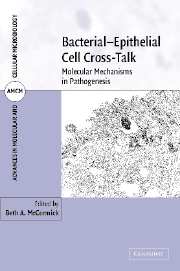Book contents
- Frontmatter
- Contents
- List of contributors
- Part I Introduction to the host and bacterial pathogens
- Part II Bacterial cell biology and pathogenesis
- 3 Bacterial secretion systems
- 4 Microbial molecular patterns and host defense
- 5 Roles of flagella in pathogenic bacteria and bacterial–host interactions
- 6 The role of bacterial adhesion to epithelial cells in pathogenesis
- 7 Bacterial toxins that modify the epithelial cell barrier
- Part III Host cell signaling by bacteria
- Part IV Exploitation of host niches by pathogenic bacteria: mechanisms and consequences
- Index
- Plate section
- References
4 - Microbial molecular patterns and host defense
from Part II - Bacterial cell biology and pathogenesis
Published online by Cambridge University Press: 12 August 2009
- Frontmatter
- Contents
- List of contributors
- Part I Introduction to the host and bacterial pathogens
- Part II Bacterial cell biology and pathogenesis
- 3 Bacterial secretion systems
- 4 Microbial molecular patterns and host defense
- 5 Roles of flagella in pathogenic bacteria and bacterial–host interactions
- 6 The role of bacterial adhesion to epithelial cells in pathogenesis
- 7 Bacterial toxins that modify the epithelial cell barrier
- Part III Host cell signaling by bacteria
- Part IV Exploitation of host niches by pathogenic bacteria: mechanisms and consequences
- Index
- Plate section
- References
Summary
INTRODUCTION
As an interface with the outside world, epithelial cells play an important role in host defense against the vast number of microbes within our midst. A central feature in such microbial–epithelial cell interactions is the use of host pattern-recognition receptors (PRR) to recognize microbes, thus enabling an appropriate response. This chapter reviews the PRRs that mediate epithelial responses, considers the mechanisms by which they function, and discusses the role of these receptors in host defense and homeostasis. The chapter is based primarily on the intestinal mucosa in light of the authors' knowledge in this area, but many of the concepts should be applicable to other mucosal surfaces. Due to the rapid pace of advancement in this area of research, PRRs are often described and partially characterized well ahead of full determinations of the tissues and cells that actually express these PRRs; thus, this chapter proceeds with a general review of PRRs and then discusses direct and indirect PRR activation of epithelial cells and the role of these activation events in host defense.
PATTERN-RECOGNITION RECEPTORS: MEDIATORS OF HOST–BACTERIAL INTERACTIONS
The immune system traditionally has been divided into innate and adaptive components, which are differentiated functionally on the basis of whether their antimicrobial action requires previous exposure to the microbe or its components. Innate immunity has long been thought to rely on some germline-encoded mechanisms to recognize foreign products.
- Type
- Chapter
- Information
- Bacterial-Epithelial Cell Cross-TalkMolecular Mechanisms in Pathogenesis, pp. 99 - 130Publisher: Cambridge University PressPrint publication year: 2006



